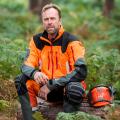
Tim Bendle, H team ambassador for Husqvarna UK, writes on the evolution of PPE and how it continues to play a critical role in transforming the arboricultural sector.
THE arboriculture industry, like many others, has witnessed significant evolution in recent years. The safety of professionals has increasingly become the focal point, which has seen the implementation of various industry-wide measures aiming to promote safer working practices and better safeguard the well-being of arborists.
THE ROLE OF MODERN MACHINERY
In recent years, there has been a notable shift towards driving safer practices across the industry. The UK guidance for tree climbing has changed, with more focus now placed on managing and reducing the potential risks associated with working at heights. The industry’s response to challenges such as ash dieback disease has also contributed towards the changes, and we’ve seen the widespread adoption of large machinery such as grapple saws and shears in response, to allow for safer working conditions.
Recent advancements in battery-powered machinery have also contributed to a safer working environment for arborists. Battery-powered chainsaws, which were once seen as less powerful alternatives to their petrol counterparts, have now emerged as a more viable and often preferable option. They’re not only quieter and produce fewer vibrations, but are also more efficient, contributing to a reduction in operator fatigue, which is often a common cause of accidents. Our team carried out some petrol vs battery-powered chainsaw comparisons a few years ago, timing the operational differences between the saws in several working situations, across both ground and aerial use. Where outright power wasn’t a considering factor, the battery-powered tools reduced the overall work time drastically, often as much as by up to 50%.
This not only helps to enhance productivity and safety, but also allows arborists to focus more on the quality of their work, which is crucial in tree care.
Additionally, the introduction of dedicated intercom systems designed specifically for arborists has had a huge impact on the way that we can work and communicate as a team. Labour-saving devices such as power ascenders, have become increasingly valuable, supporting with a reduction in fatigue, and the ability for a grounds person to access a tree quickly in the event of an aerial rescue.
THE EVOLUTION OF PPE
The evolution of PPE has played a critical role in transforming our daily experience. When I started in the arboriculture industry almost 40 years ago, options for PPE were extremely limited, often uncomfortable and poorly suited to the demands of the job.
Today, I’m pleased to see that arborists have access to a wide range of workwear and PPE, designed with comfort, safety and performance in mind. This shift has not only enhanced safety by ensuring that arborists are more likely to wear their PPE correctly, but also makes the workday more enjoyable. In an industry where weather conditions can vary dramatically, having comfortable, functional workwear makes all the difference.
ATTRACTING AND RETAINING TALENT
The improvements in safety, comfort, and efficiency have had a positive impact on attracting and retaining talent within the arboriculture industry. The availability of advanced equipment and machinery has made the work less physically demanding and more enjoyable, appealing to a broader range of professionals. Something I have observed in my time in the industry, and especially with my involvement in the training sector, is that there is now a far wider age range working in the tree care industry than ever before, and many more people entering the industry later in life.
WANT MORE LIKE THIS?
- APF 2024: Husqvarna's 542i XP, a world-first battery saw
- APF 2024: The joy of the Husqvarna World Poleclimbing Championships
By making the role more accessible and sustainable, the industry is now better positioned to attract new talent and retain experienced professionals, ensuring a steady supply of skilled labour in the future.
STRIKING A BALANCE
As the focus on safety intensifies, sometimes the well-being of trees and the understanding of how to best maintain a tree, can be overlooked. Risk mitigation has become the leading priority, which has led to larger machinery being used to do less sensitive tree care, and more trees being removed than retained. Striking the balance between mitigating risks and preserving the health of the tree for years to come is a challenge the industry is currently navigating, in line with a greater emphasis on the safety of arborists.
THE FUTURE OF ARBORICULTURE
Like many land-based industries, technology will no doubt make the role of an arborist safer, less physically demanding and more efficient. Advancement in climbing equipment and techniques will continue to improve safety and efficiency for the tree climber. For example, the development of more powerful and robust battery-operated machinery will not only improve the operator experience but also reduce noise and pollution disturbance. In addition, more advanced self-propelled mobile elevating work platforms will reduce the need to climb, giving more pruning opportunities to non-climbers. Finally, larger machinery such as grapple saws will help enable heavy and often dangerous aerial work to be done from the ground.
Ultimately, technology should serve to enhance the arborist’s role, making the job safer, less physically demanding, and more enjoyable. As the industry continues to evolve, it is crucial to maintain a focus on both the safety of the arborist and the preservation of the trees.




Comments: Our rules
We want our comments to be a lively and valuable part of our community - a place where readers can debate and engage with the most important local issues. The ability to comment on our stories is a privilege, not a right, however, and that privilege may be withdrawn if it is abused or misused.
Please report any comments that break our rules.
Read the rules here